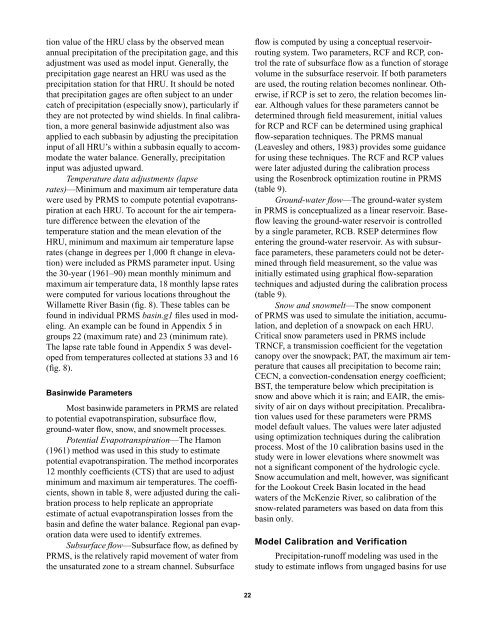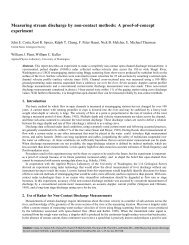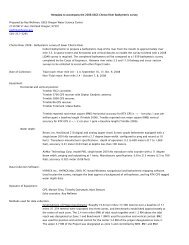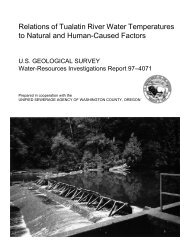Precipitation-Runoff and Streamflow-Routing Models for the ...
Precipitation-Runoff and Streamflow-Routing Models for the ...
Precipitation-Runoff and Streamflow-Routing Models for the ...
- No tags were found...
You also want an ePaper? Increase the reach of your titles
YUMPU automatically turns print PDFs into web optimized ePapers that Google loves.
tion value of <strong>the</strong> HRU class by <strong>the</strong> observed meanannual precipitation of <strong>the</strong> precipitation gage, <strong>and</strong> thisadjustment was used as model input. Generally, <strong>the</strong>precipitation gage nearest an HRU was used as <strong>the</strong>precipitation station <strong>for</strong> that HRU. It should be notedthat precipitation gages are often subject to an undercatch of precipitation (especially snow), particularly if<strong>the</strong>y are not protected by wind shields. In final calibration,a more general basinwide adjustment also wasapplied to each subbasin by adjusting <strong>the</strong> precipitationinput of all HRU’s within a subbasin equally to accommodate<strong>the</strong> water balance. Generally, precipitationinput was adjusted upward.Temperature data adjustments (lapserates)—Minimum <strong>and</strong> maximum air temperature datawere used by PRMS to compute potential evapotranspirationat each HRU. To account <strong>for</strong> <strong>the</strong> air temperaturedifference between <strong>the</strong> elevation of <strong>the</strong>temperature station <strong>and</strong> <strong>the</strong> mean elevation of <strong>the</strong>HRU, minimum <strong>and</strong> maximum air temperature lapserates (change in degrees per 1,000 ft change in elevation)were included as PRMS parameter input. Using<strong>the</strong> 30-year (1961–90) mean monthly minimum <strong>and</strong>maximum air temperature data, 18 monthly lapse rateswere computed <strong>for</strong> various locations throughout <strong>the</strong>Willamette River Basin (fig. 8). These tables can befound in individual PRMS basin.g1 files used in modeling.An example can be found in Appendix 5 ingroups 22 (maximum rate) <strong>and</strong> 23 (minimum rate).The lapse rate table found in Appendix 5 was developedfrom temperatures collected at stations 33 <strong>and</strong> 16(fig. 8).Basinwide ParametersMost basinwide parameters in PRMS are relatedto potential evapotranspiration, subsurface flow,ground-water flow, snow, <strong>and</strong> snowmelt processes.Potential Evapotranspiration—The Hamon(1961) method was used in this study to estimatepotential evapotranspiration. The method incorporates12 monthly coefficients (CTS) that are used to adjustminimum <strong>and</strong> maximum air temperatures. The coefficients,shown in table 8, were adjusted during <strong>the</strong> calibrationprocess to help replicate an appropriateestimate of actual evapotranspiration losses from <strong>the</strong>basin <strong>and</strong> define <strong>the</strong> water balance. Regional pan evaporationdata were used to identify extremes.Subsurface flow—Subsurface flow, as defined byPRMS, is <strong>the</strong> relatively rapid movement of water from<strong>the</strong> unsaturated zone to a stream channel. Subsurfaceflow is computed by using a conceptual reservoirroutingsystem. Two parameters, RCF <strong>and</strong> RCP, control<strong>the</strong> rate of subsurface flow as a function of storagevolume in <strong>the</strong> subsurface reservoir. If both parametersare used, <strong>the</strong> routing relation becomes nonlinear. O<strong>the</strong>rwise,if RCP is set to zero, <strong>the</strong> relation becomes linear.Although values <strong>for</strong> <strong>the</strong>se parameters cannot bedetermined through field measurement, initial values<strong>for</strong> RCP <strong>and</strong> RCF can be determined using graphicalflow-separation techniques. The PRMS manual(Leavesley <strong>and</strong> o<strong>the</strong>rs, 1983) provides some guidance<strong>for</strong> using <strong>the</strong>se techniques. The RCF <strong>and</strong> RCP valueswere later adjusted during <strong>the</strong> calibration processusing <strong>the</strong> Rosenbrock optimization routine in PRMS(table 9).Ground-water flow—The ground-water systemin PRMS is conceptualized as a linear reservoir. Baseflowleaving <strong>the</strong> ground-water reservoir is controlledby a single parameter, RCB. RSEP determines flowentering <strong>the</strong> ground-water reservoir. As with subsurfaceparameters, <strong>the</strong>se parameters could not be determinedthrough field measurement, so <strong>the</strong> value wasinitially estimated using graphical flow-separationtechniques <strong>and</strong> adjusted during <strong>the</strong> calibration process(table 9).Snow <strong>and</strong> snowmelt—The snow componentof PRMS was used to simulate <strong>the</strong> initiation, accumulation,<strong>and</strong> depletion of a snowpack on each HRU.Critical snow parameters used in PRMS includeTRNCF, a transmission coefficient <strong>for</strong> <strong>the</strong> vegetationcanopy over <strong>the</strong> snowpack; PAT, <strong>the</strong> maximum air temperaturethat causes all precipitation to become rain;CECN, a convection-condensation energy coefficient;BST, <strong>the</strong> temperature below which precipitation issnow <strong>and</strong> above which it is rain; <strong>and</strong> EAIR, <strong>the</strong> emissivityof air on days without precipitation. Precalibrationvalues used <strong>for</strong> <strong>the</strong>se parameters were PRMSmodel default values. The values were later adjustedusing optimization techniques during <strong>the</strong> calibrationprocess. Most of <strong>the</strong> 10 calibration basins used in <strong>the</strong>study were in lower elevations where snowmelt wasnot a significant component of <strong>the</strong> hydrologic cycle.Snow accumulation <strong>and</strong> melt, however, was significant<strong>for</strong> <strong>the</strong> Lookout Creek Basin located in <strong>the</strong> headwaters of <strong>the</strong> McKenzie River, so calibration of <strong>the</strong>snow-related parameters was based on data from thisbasin only.Model Calibration <strong>and</strong> Verification<strong>Precipitation</strong>-runoff modeling was used in <strong>the</strong>study to estimate inflows from ungaged basins <strong>for</strong> use22







